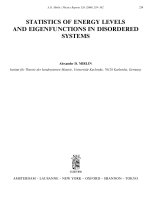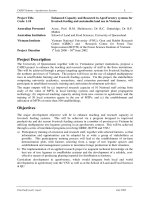Vulnerabilities and Threats in Distributed Systems
Bạn đang xem bản rút gọn của tài liệu. Xem và tải ngay bản đầy đủ của tài liệu tại đây (761.09 KB, 56 trang )
Vulnerabilities and Threats
in Distributed Systems*
Prof. Bharat Bhargava
Dr. Leszek Lilien
Department of Computer Sciences and
the Center for Education and Research in Information Assurance and Security (CERIAS )
Purdue University
www.cs.purdue.edu/people/{bb, llilien}
Presented by
Prof. Sanjay Madria
Department of Computer Science
University of MissouriRolla
Supported in part by NSF grants IIS0209059 and IIS0242840
*
Prof. Bhargava thanks the organizers of the 1st International
Conference on Distributed Computing & Internet Technology—ICDCIT
2004. In particular, he thanks:
Prof. R. K. Shyamsunder
Prof. Hrushikesha Mohanty
Prof. R.K. Ghosh
Prof. Vijay Kumar
Prof. Sanjay Madria
He thanks the attendees, and regrets that he could not be present.
He came to Bhubaneswar in 2001 and enjoyed it tremendously. He was
looking forward to coming again.
He will be willing to communicate about this research. Potential exists
for research collaboration. Please send mail to
He will very much welcome your visit to Purdue University.
ICDCIT 2004
2
From Vulnerabilities to Losses
Growing business losses due to vulnerabilities in distributed
systems
Vulnerabilities occur in:
Identity theft in 2003 – expected loss of $220 bln worldwide ; 300%(!)
annual growth rate [csoonline.com, 5/23/03]
Computer virus attacks in 2003 – estimated loss of $55 bln worldwide
[news.zdnet.com, 1/16/04]
Hardware / Networks / Operating Systems / DB systems / Applications
Loss chain
Dormant vulnerabilities enable threats against systems
Potential threats can materialize as (actual) attacks
Successful attacks result in security breaches
Security breaches cause losses
ICDCIT 2004
3
Vulnerabilities and Threats
Vulnerabilities and threats start the loss chain
Best to deal with them first
Deal with vulnerabilities
Gather in metabases and notification systems info on
vulnerabilities and security incidents, then disseminate it
Example vulnerability and incident metabases
Example vulnerability notification systems
CVE (Mitre), ICAT (NIST), OSVDB (osvdb.com)
CERT (SEICMU), Cassandra (CERIASPurdue)
Deal with threats
Threat assessment procedures
Specialized risk analysis using e.g. vulnerability and incident info
Threat detection / threat avoidance / threat tolerance
ICDCIT 2004
4
Outline
1. Vulnerabilities
2. Threats
3. Mechanisms to Reduce Vulnerabilities
and Threats
3.1. Applying Reliability and Fault Tolerance
Principles to Security Research
3.2. Using Trust in Rolebased Access
Control
3.3. Privacypreserving Data Dissemination
3.4. Fraud Countermeasure Mechanisms
ICDCIT 2004
5
Vulnerabilities Topics
Models for Vulnerabilities
Fraud Vulnerabilities
Vulnerability Research Issues
ICDCIT 2004
6
Models for Vulnerabilities (1)
A vulnerability in security domain – like a fault in
reliability domain
Modeling vulnerabilities
A flaw or a weakness in system security procedures,
design, implementation, or internal controls
Can be accidentally triggered or intentionally exploited,
causing security breaches
Analyzing vulnerability features
Classifying vulnerabilities
Building vulnerability taxonomies
Providing formalized models
System design should not let an adversary know
vulnerabilities unknown to the system owner
ICDCIT 2004 7
Models for Vulnerabilities (2)
Diverse models of vulnerabilities in the literature
Analysis of four common computer vulnerabilities [17]
In various environments
Under varied assumptions
Examples follow
Identifies their characteristics, the policies violated by their
exploitation, and the steps needed for their eradication in
future software releases
Vulnerability lifecycle model applied to three case
studies [4]
Shows how systems remains vulnerable long after security
fixes
Vulnerability lifetime stages:
appears, discovered, disclosed, corrected, publicized, disappears
ICDCIT 2004
8
Models for Vulnerabilities (3)
Modelbased analysis to identify configuration
vulnerabilities [23]
Formal specification of desired security properties
Abstract model of the system that captures its security
related behaviors
Verification techniques to check whether the abstract
model satisfies the security properties
Kinds of vulnerabilities [3]
Operational
E.g. an unexpected broken linkage in a distributed database
Informationbased
E.g. unauthorized access (secrecy/privacy), unauthorized
modification (integrity), traffic analysis (inference problem), and
Byzantine input
ICDCIT 2004
9
Models for Vulnerabilities (4)
Not all vulnerabilities can be removed, some shouldn’t
Because:
Vulnerabilities create only a potential for attacks
Some vulnerabilities cause no harm over entire system’s life cycle
Some known vulnerabilities must be tolerated
Removal of some vulnerabilities may reduce usability
E.g., removing vulnerabilities by adding passwords for each resource
request lowers usability
Some vulnerabilities are a side effect of a legitimate system feature
Due to economic or technological limitations
E.g., the setuid UNIX command creates vulnerabilities [14]
Need threat assessment to decide which vulnerabilities to
remove first
ICDCIT 2004
10
Fraud Vulnerabilities (1)
Fraud:
a deception deliberately practiced in order to secure unfair
or unlawful gain [2]
Examples:
Using somebody else’s calling card number
Unauthorized selling of customer lists to telemarketers
(example of an overlap of fraud with privacy breaches)
Fraud can make systems more vulnerable to
subsequent fraud
Need for protection mechanisms to avoid future damage
ICDCIT 2004
11
Fraud Vulnerabilities (2)
Fraudsters: [13]
Impersonators
illegitimate users who steal resources from victims
(for instance by taking over their accounts)
Swindlers
legitimate users who intentionally benefit from the system or
other users by deception
(for instance, by obtaining legitimate telecommunications
accounts and using them without paying bills)
Fraud involves abuse of trust [12, 29]
Fraudster strives to present himself as a trustworthy
individual and friend
The more trust one places in others the more vulnerable
one becomes
ICDCIT 2004
12
Vulnerability Research Issues (1)
Analyze severity of a vulnerability and its potential
impact on an application
Qualitative impact analysis
Quantitative impact
Expressed as a low/medium/high degree of
performance/availability degradation
E.g., economic loss, measurable cascade effects, time to
recover
Provide procedures and methods for efficient
extraction of characteristics and properties of
known vulnerabilities
Analogous to understanding how faults occur
Tools searching for known vulnerabilities in metabases
can not anticipate attacker behavior
Characteristics of highrisk vulnerabilities can be learnt
from the behavior of attackers, using honeypots, etc.
ICDCIT 2004 13
Vulnerability Research Issues (2)
Construct comprehensive taxonomies of
vulnerabilities for different application areas
Medical systems may have critical privacy vulnerabilities
Vulnerabilities in defense systems compromise
homeland security
Propose good taxonomies to facilitate both
prevention and elimination of vulnerabilities
Enhance metabases of vulnerabilities/incidents
Reveals characteristics for preventing not only identical
but also similar vulnerabilities
Contributes to identification of related vulnerabilities,
including dangerous synergistic ones
Good model for a set of synergistic vulnerabilities can lead to
uncovering gang attack threats or incidents
ICDCIT 2004
14
Vulnerability Research Issues (3)
Provide models for vulnerabilities and their contexts
The challenge: how vulnerability in one context
propagates to another
If Dr. Smith is a highrisk driver, is he a trustworthy doctor?
Different kinds of vulnerabilities emphasized in different
contexts
Devise quantitative lifecycle vulnerability models for
a given type of application or system
Exploit unique characteristics of vulnerabilities &
application/system
In each lifecycle phase:
determine most dangerous and common types of vulnerabilities
use knowledge of such types of vulnerabilities to prevent them
Best defensive procedures adaptively selected from a
predefined set
ICDCIT 2004
15
Vulnerability Research Issues (4)
The lifecycle models helps solving a few problems
Avoiding system vulnerabilities most efficiently
Evaluations/measurements of vulnerabilities at each
lifecycle stage
By discovering & eliminating them at design and implementation
stages
In system components / subsystems / of the system as a whole
Assist in most efficient discovery of vulnerabilities before
they are exploited by an attacker or a failure
Assist in most efficient elimination / masking of vulnerabilities
(e.g. based on principles analogous to faulttolerance)
OR:
Keep an attacker unaware or uncertain of important system
parameters
(e.g., by using nondeterministic or deceptive system behavior, increased
component diversity, or multiple lines of defense)
ICDCIT 2004
16
Vulnerability Research Issues (5)
Provide methods of assessing impact of
vulnerabilities on security in applications & systems
Create formal descriptions of the impact of vulnerabilities
Develop quantitative vulnerability impact evaluation methods
Use resulting ranking for threat/risk analysis
Identify the fundamental design principles and guidelines for dealing
with system vulnerabilities at each lifecycle stage
Propose best practices for reducing vulnerabilities at all lifecycle
stages (based on the above principles and guidelines)
Develop interactive or fully automatic tools and infrastructures
encouraging or enforcing use of these best practices
Other issues:
Investigate vulnerabilities in security mechanisms themselves
Investigate vulnerabilities due to nonmalicious but threatenabling
uses of information [21]
ICDCIT 2004
17
Outline
1. Vulnerabilities
2. Threats
3. Mechanisms to Reduce Vulnerabilities
and Threats
3.1. Applying Reliability and Fault Tolerance
Principles to Security Research
3.2. Using Trust in Rolebased Access
Control
3.3. Privacypreserving Data Dissemination
3.4. Fraud Countermeasure Mechanisms
ICDCIT 2004
18
Threats Topics
Models of Threats
Dealing with Threats
Threat Avoidance
Threat Tolerance
Fraud Threat Detection for Threat
Tolerance
Fraud Threats
Threat Research Issues
ICDCIT 2004
19
Models of Threats
Threats in security domain – like errors in reliability domain
Entities that can intentionally exploit or inadvertently trigger specific
system vulnerabilities to cause security breaches [16, 27]
Attacks or accidents materialize threats (changing them from
potential to actual)
Attack an intentional exploitation of vulnerabilities
Accident an inadvertent triggering of vulnerabilities
Threat classifications: [26]
Based on actions, we have:
threats of illegal access, threats of destruction, threats of modification,
and threats of emulation
Based on consequences, we have:
threats of disclosure, threats of (illegal) execution, threats of
misrepresentation, and threats of repudiation
ICDCIT 2004
20
Dealing with Threats
Dealing with threats
Avoid (prevent) threats in systems
Detect threats
Eliminate threats
Tolerate threats
Deal with threats based on degree of risk
acceptable to application
Avoid/eliminate threats to human life
Tolerate threats to noncritical or redundant components
ICDCIT 2004
21
Dealing with Threats –
Threat Avoidance (1)
Design of threat avoidance techniques analogous
to fault avoidance (in reliability)
Threat avoidance methods are frozen after system
deployment
Effective only against less sophisticated attacks
Sophisticated attacks require adaptive schemes for
threat tolerance [20]
Attackers have motivation, resources, and the whole
system lifetime to discover its vulnerabilities
Can discover holes in threat avoidance methods
ICDCIT 2004
22
Dealing with Threats –
Threat Avoidance (2)
Understanding threat sources
Understand threats by humans, their motivation and
potential attack modes [27]
Understand threats due to system faults and failures
Example design guidelines for preventing threats:
Model for secure protocols [15]
Formal models for analysis of authentication protocols [25,
10]
Models for statistical databases to prevent data
disclosures [1]
ICDCIT 2004
23
Dealing with Threats –
Threat Tolerance
Useful features of faulttolerant approach
Not concerned with each individual failure
Don’t spend all resources on dealing with individual failures
Can ignore transient and noncatastrophic errors and failures
Need analogous intrusiontolerant approach
Deal with lesser and common security breaches
E.g.: intrusion tolerance for database systems [3]
Phase 1: attack detection
Phases 25: damage confinement, damage assessment, reconfiguration,
continuation of service
Optional (e.g., majority voting schemes don’t need detection)
can be implicit (e.g., voting schemes follow the same procedure whether attacke
or not)
Phase 6: report attack
to repair and fault treatment (to prevent a recurrence of similar attacks)
ICDCIT 2004
24
Dealing with Threats – Fraud Threat
Detection for Threat Tolerance
Fraud threat identification is needed
Fraud detection systems
Widely used in telecommunications, online transactions,
insurance
Effective systems use both fraud rules and pattern
analysis of user behavior
Challenge: a very high false alarm rate
Due to the skewed distribution of fraud occurrences
ICDCIT 2004
25









